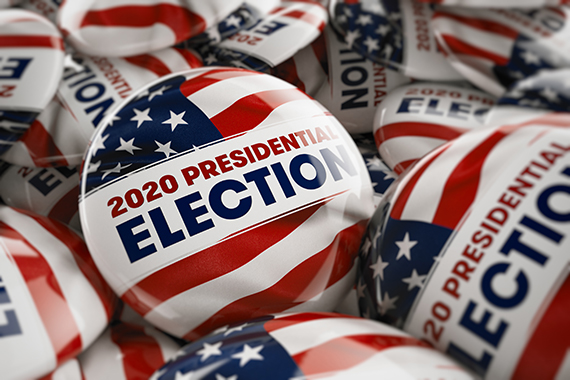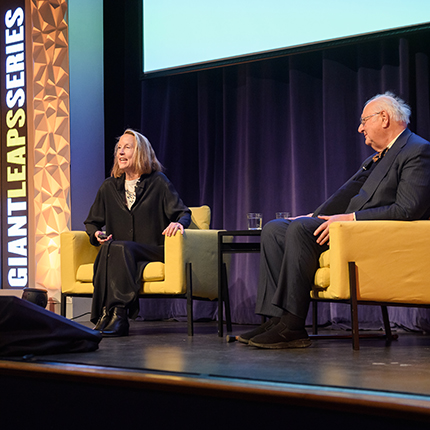 Karthik Kannan, the Thomas Howatt Chaired Professor in Management at Purdue University, has pioneered a research concept called “design for instincts” that has subtle and far-reaching implications not only for business, but also for politics. (Stock image)
Karthik Kannan, the Thomas Howatt Chaired Professor in Management at Purdue University, has pioneered a research concept called “design for instincts” that has subtle and far-reaching implications not only for business, but also for politics. (Stock image)
Nudging Bias
Designing for instincts in presidential politics
When Donald Trump defeated Hillary Clinton in the 2016 U.S. presidential election, many voters and political pundits were surprised by the outcome.
But the campaign strategies used by the opposing candidates were entirely predictable, says Karthik Kannan, an expert in big data who studies systems that exploit instincts and biases to nudge human behavior.
Kannan, the Thomas Howatt Chaired Professor in Management at Purdue University, has pioneered a research concept called “design for instincts” that he defines as designing systems in a manner that is instinctually appealing and allows people to respond intuitively. He says the approach has subtle and far-reaching implications not only for business, but also for politics.
“It is a very simple yet profound concept,” says Kannan, who also serves as director of the Krannert School’s Business Information and Analytics Center (BIAC). “If we can successfully use a marketing campaign to appeal to the human instincts of a targeted audience to achieve a desired business outcome, why can’t the same strategies be applied to a political campaign?”
In the retail industry, for example, one common strategy is to shape consumer behavior by manipulating the supply chain. Kannan says companies can simply restrict the number of items that are available at a store, which creates scarcity and makes people instinctually want to buy a product before its inventory is exhausted.
“Running out of stock, which is typically to be avoided in a supply-chain context, becomes a key attribute in helping to sell the product,” he says.
According to Kannan, the trend toward design for instincts in politics actually emerged during the 2012 presidential race with the introduction of Orca, a web application designed by GOP candidate Mitt Romney’s campaign to “get out the vote” in underperforming Republican precincts.
The platform was created as a countermeasure to Narwhal, a computer program used by President Barack Obama’s reelection team that relied on data analytics to micro- target Democratic voters.
Although technical problems ultimately led to Orca’s failure, Kannan believes the Obama team’s success with Narwhal signaled a foundational shift in how political campaigns are now being conducted.
“If the 2012 election was about big data, the 2016 election was undoubtedly about design for instincts,” he says. “No other domain has a more significant appeal to instincts than politics — it is embedded in our societies and nearly every form of government. In fact, politics is one of the few contexts where we truly talk about ‘grassroots’ and how to excite a particular base of people. No matter which party voters favor, they argue for their position from the standpoint of instincts.
At its most genteel level, Kannan says design for instincts in politics is exemplified by the traditional differences between conservatives and liberals.
“A number of my Democratic friends argue from the position of compassion for their fellow citizens when asking for governmental interventions or regulations,” he says. “Similarly, a number of my Republican friends argue from the position of freedom when rejecting government interventions and regulations. There is a clear demarcation of views and rarely people switch positions.”
At a more base level, however, the differences can become murky and divisive. “Political parties are organized like teams, so elections become a form of competition between opposing sides,” Kannan says. “When we compete, our instincts to behave like warring tribes kicks in. That’s why we continue to see conflicting and sometimes irrational policies and actions pursued by both parties.”
While one party might support its position on gun control or border security by appealing to people’s instinctual fear of violence and desire for safety, for example, the other party might appeal to the same instincts to support its position on defense spending or immigration.
“Our individual instincts to support the positions of our chosen party and our tribal instincts to war with one another are the key motivators for engagement in politics,” Kannan says. “Arousing either or both of these instincts is fundamental to driving successful campaigns.”
And regardless of whom you supported in the 2016 presidential election, Kannan says it’s clear that the Trump campaign was more effective at designing for the instincts of voters than the Clinton campaign.
Duplicating or countering that success in midterm elections is difficult for either party because the logistics and dynamics of state and local politics vary so widely, Kannan says. But he expects the trend toward design for instincts in presidential politics to evolve and grow even stronger as the 2020 election draws closer.
“Technology inevitably matures, so it doesn’t take a giant leap in logic to realize that what worked for Trump in 2016 could produce very different results in the next presidential election,” Kannan says. “If either party focuses only on its past successes or failures, they are likely to be outwitted.”









